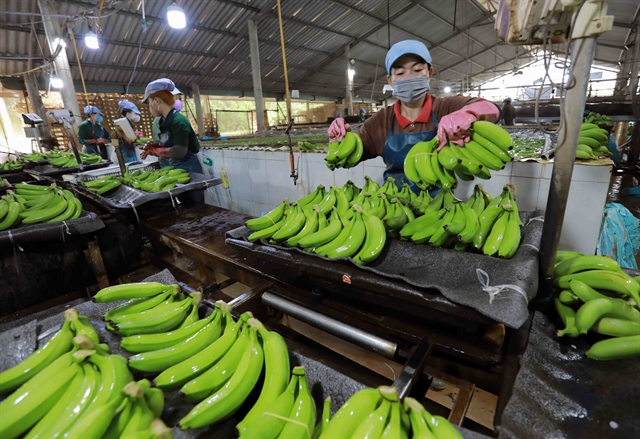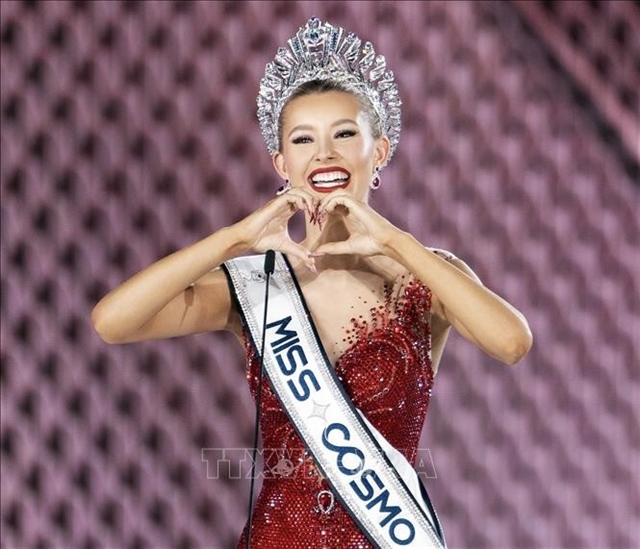 Opinion
Opinion

 |
| Green bananas packed for export in Long An Province. — VNA/VNS Photo |
Minister of Agriculture and Rural Development Lê Minh Hoan speaks to Nhân Dân (People) newspaper about the opportunities and challenges of the agricultural sector in 2024 and actions to be taken to realise targets.
Based on results achieved in 2023, could you comment on the efforts made by farmers, the agricultural sector and Việt Nam in general in adapting to market fluctuations?
In 2023, in the context of many challenges, the agricultural sector's exports still achieved outstanding results.
The sector's GDP witnessed its highest growth in recent years, estimated at 3.83 per cent. Export value reached more than US$53 billion and the sector continued to affirm its position as a pillar of the economy, firmly ensuring food security, major balances of the economy and stabilising the macro-economy.
Based on the results achieved, we can see that the agricultural sector has adapted quite quickly. Vietnamese business communities and farmers have responded quite well to fluctuations of domestic and foreign markets.
Although some areas like fisheries, forestry and animal husbandry faced difficulties at certain times, we can still bring into play our potential, thanks to the attention paid by the Party and State, flexible policies to open the market, promotional campaigns, online conferences between the country and major markets, as well as the assistance of Vietnamese diplomatic agencies abroad.
In the context of food security challenges, Việt Nam has become a food security destination for countries around the world.
Difficulties in food security have forced some countries with developed rice industries, such as India, to close exports to ensure food security. Meanwhile, Việt Nam can both ensure domestic food security and engage in the global rice market.
This once again affirms that Việt Nam is a responsible country with transparent and sustainable agriculture.
To reach those achievements, the agricultural sector and farmers have made strong "transformations" in thinking and action. Could you elaborate on that effort?
The first thing to mention is the change in the market. Việt Nam has gradually diversified its markets and products.
Previously, we sold products in the low-end market, but now we have many classes of products in the high-end, mid-range and low-end markets. We are shifting from agricultural production thinking to agricultural economic thinking, from single-value to multi-value growth.
In the past, farmers only grew rice, but now there are many flexible models such as rice-seaworm fields in Hải Dương and Hải Phòng, and shrimp-rice fields and fish-rice fields in the Mekong Delta.
Agriculture is no longer just about growing crops and raising livestock, but has been integrated into many industries to create higher value.
We see that One Commune, One Product (OCOP) certification is multi-value integration. Farmers no longer sell only raw materials, but have taken advantages of local resources to create new product lines.
The agricultural sector still has a lot of room to develop. Changing the mindset and production will create products adapted to different market segments. That is an opportunity for Việt Nam to move towards a stable agricultural industry, an ecological agriculture that puts environmentally-friendly, organic production methods into practice.
To be able to enter high-end markets, products must meet specific criteria, many of which are difficult for businesses and farmers to achieve. What approach do you suggest to overcome this problem?
It's time for us to reconsider the value of the agricultural products we make. Because now, domestic and international customers not only buy products but also buy their values.
European Union ambassadors to Việt Nam shared that in the future, products exported to the EU market will be more strictly regulated.
For example, wood products will not only need to meet the EU regulations on combatting deforestation and forest degradation, but will also need to consider the origin of the product, possible use of child labour, fossil energy use, and the products’ effect on the environment and climate.
If a product uses imported raw materials, it is necessary to trace whether the countries exporting the raw materials meet EU requirements or not. If they do not comply with the regulations, the EU will not import our products. That story may not happen today, but such regulations are certainly on the European Union's agenda.
From a simple perspective, we might think that European countries set strict criteria to put us into a difficult situation, but objectively, those criteria contribute to creating a healthy, competitive environment between countries.
European countries must also comply with the above regulations, they are even the pioneers in applying those regulations towards green, clean and sustainable agriculture.
As the costs to follow these regulations are high, if the regulations on imported products are not tightened, it will create unfair competition for their own countries’ products.
I want to emphasise again that we must adapt to changing trends. The global greening trend is irreversible; we should never wish to return to the old days.
The Prime Minister has affirmed that Việt Nam is ready to commit to building a sustainable agricultural sector. Việt Nam is a developing country so it needs the EU's companionship to gradually move towards a solid, ecological, nature-based organic sector.
European countries are also willing to share funding sources to help us gradually realise that goal. Change is inevitable, and whichever country goes first will gain advantages.
Recently, the word “green” has been used a lot, especially in agriculture. We have a green agricultural sector, green thinking. How do a green mindset and actions develop green agriculture?
When it comes to a green mindset, I think it's time to be clearer about the meaning of these key words.
We often say that agriculture is green, the economy is green, but actually the word “green” comes after the word “brown”.
Previously, ours was a brown economy, which means development deformed the environment. Literally speaking, we are abusing the environment to feed humans, creating environmental distortions and biological distortions.
We think that we are creating an economy to feed people, but we forget that invisibly, people living in a polluted environment are also seriously injured. Humans cannot exist without a green environment around them. The green environment helps us return to a balance between development and preservation.
There are times we think that if we want economic development, we have to make sacrifices.
But now with technological development, that problem can be solved. For example, in the past, to grow rice with high yields and quality, we had to accept the effect of greenhouse gas emissions. High-value aquaculture had to accept methane gas.
But by applying science and technology to agriculture, we can completely implement the project on one million hectares of rice and aquaculture projects, and still ensure sustainable development.
However, turning to a green mindset and green lifestyle is a long process. In developed countries, the green lifestyle is introduced at schools from the pre-school level. People have nurtured green thinking among students at the youngest level and gradually developed it at higher levels. This is a long process and if we don't take action, we will fall behind. — VNS




